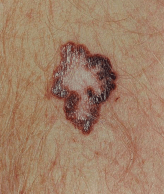TERT Promoter Mutations Common in Melanoma
Source: Cancer Network, October 2014

A recent study has confirmed that TERT promoter mutations are common genetic mutations in cutaneous melanoma, and that these mutations may be linked with poor prognosis in certain subtypes of the disease.
Prior research had identified frequent mutations in the promoter region of the TERT gene in melanoma, as well as bladder cancer, hepatocellular carcinoma, thyroid cancer, and types of gliomas.
This study, published in the Journal of the National Cancer Institute, was designed to determine the frequency of these mutations in various subtypes of melanoma and to establish if they were linked with prognosis.
Klaus G. Griewank, MD, of the department of dermatology at University Hospital Essen, Germany, and colleagues analyzed 410 melanoma tumors samples for the presence of TERT promoter mutations. They then conducted an analysis attempting to identify any connection between these mutations and various clinical and pathologic characteristics. Sequencing was successful in 362 patients and follow-up data were available for 353 patients.
TERT promoter mutations were found in 43% of the sequenced melanomas. The mutations occurred more commonly in melanomas arising in non-acral skin (48%) and melanomas with occult primary (50%). The mutations were identified less in mucosal (23%) and acral melanomas (19%).
“Interestingly, even looking at subgroups, we failed to find the comparably high percentages (> 70%) of TERT promoter mutations that have previously been reported in cell lines, short-term cultures, or matched metastasis,” the researchers wrote.
Data showed that TERT promoter mutations were more common in tumors with BRAF or NRAS mutations (P < .001), in tumors of non-acral skin compared with those of acral or mucosal locations (P = .001), in nodular and superficial spreading histologic types (P = .002), and thicker tumors (P < .001).
The researchers examined if promoter mutations were associated with prognosis. A link was found between TERT promoter mutation and worse overall survival in patients with non-acral cutaneous melanomas. These patients had a median overall survival of 80 months compared with 291 months for patients with wild-type disease (P = .006).
“Analysis of independent, prospectively collected data sets will be needed to validate our findings,” the researchers wrote. “Additional studies could further investigate whether TERT promoter mutations are of therapeutic relevance, either in terms of influencing the efficacy of established therapies or whether they might even prove to be valuable direct therapeutics targets.”
